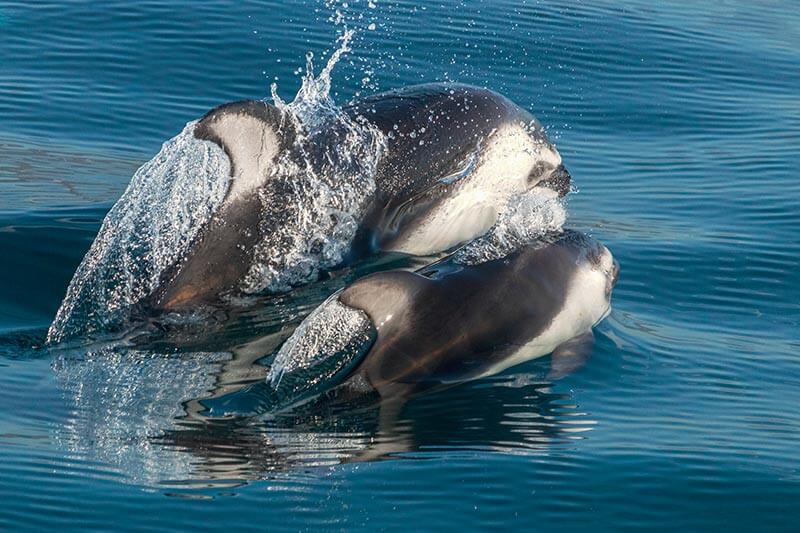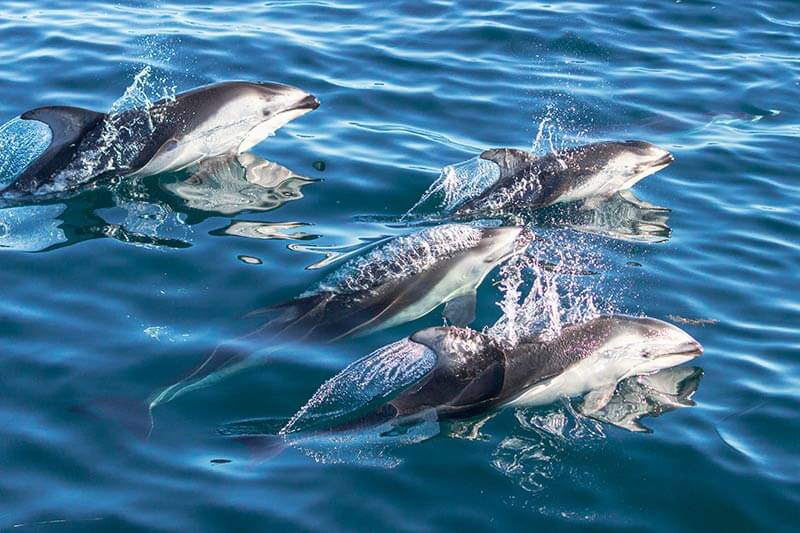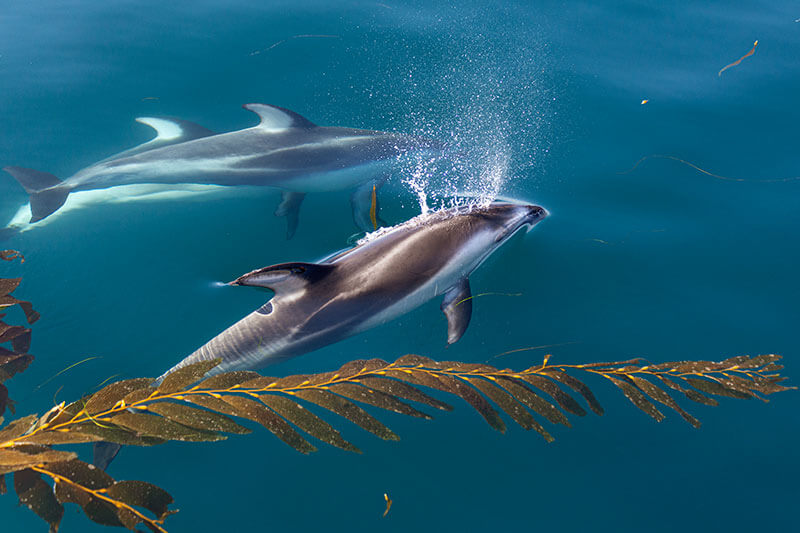Pacific White-sided Dolphin Fast Facts
Scientific name: Lagenorhynchus obliquidens
Class: Mammalia
Average length: 5.5 to 8 feet
Average weight: 300 to 400 pounds
Cruising speed: Up to 20 miles per hour
Gestation period: 9 to 12 months
Favorite snack: Fish and chips, head first
Favorite tunes: Frank Ocean
Favorite pastime: Salsa dancing
Pacific White-sided Dolphins: Dive Deeper
Underneath the sunny skies of Southern California in Dana Point, California, more than five different species of dolphins are spotted. From common to bottlenose and Risso’s, our underwater backyard is filled with jovial swimmers that continually place a smile on our face, yet out of all the cetaceans we say hello to, one leaves us awe-struck and captivated by its incredible self. This playful pal is best known as the Pacific white-sided dolphin.
Pacific white-sided dolphins are a highly playful and social marine mammal, often recognized by their astounding beauty. In fact, if these fellas were to dive in as a contestant in a beauty show pageant, they may just take the crab cake for being one of the most gorgeous creatures out at sea. Distinguished by their distinct coloring of shades of black, grey and white, they can at times be confused with common dolphins and Dall’s porpoises, but when looked at more closely, one would be able to spot their unique features that aid in their alluring persona.
Appearance
Measuring between 5.5 to 8 feet and weighing in at 300 to 400 pounds, these dolphins are glammed up with somewhat of a black, gray and white monochromatic color scheme that blends together into an amazing pattern of pigmentation. They have a light gray to white stripe that stretches along each side of their robust body and extends from the eye to the tail, resembling a pair of snazzy “suspenders.” These suspenders add to the pizazz of these pacific white-sided dolphins who also have a black back, tail and a pair of lips. Their sides, flippers, and dorsal fin are gray and their belly is white. Their gray dorsal fin sits atop their black back and is fairly large in comparison with the rest of their body. Two curious and bright eyes are met with a short snout/rostrum that rests at the end of their friendly face.
There subtle yet striking beauty is what gives them their name as the Pacific White-Sided Dolphin, but they are scientifically known as the Lagenorhynchus Obliqeidens. Try saying that three times fast! This tongue twister title is what awards them with their nickname, “Lags.”
Where do Pacific white-sided dolphins live?
These Lags touch down in a variety of locations across the globe including the temperate waters of the North Pacific Ocean. Because this species is pelagic, meaning they reside in the open ocean and north shore waters rather than close to shore where your toes are buried in the sand, they can be found in the seas of Yellow and East China, Japan, Okhostk, and the southern Bering Sea. Closer to North America, they can be spotted from California to Oregon, Washington, and Alaska.

Diet
When not putting on some of our favorite Cirque de Solei somersaults and shows, they can be busy jetting about as they grab up their grub. Choosing from a menu of squid and small schooling fish such as anchovies, sardines, and herring. They eat nearly 20 pounds of prey per day and dive for up to six minutes to round up their feast. These pickings are consumed in a unique manner for these picky eaters as they use their small conical teeth to grip the grub instead of chewing it, thus enabling them to swallow it whole – head first – so that they don’t catch the scaley spines of their fish filet friends.
Mothers and Calves
Depending on gender, they reach sexual maturity around age 10 with the males at 10 years and the females between 8 and 11. Upon reaching puberty, this species mate and give birth from late spring to fall, excluding those in the central pacific who save their baby showers until late winter to spring when they will give birth. Pregnancy will last anywhere from 9 to 12 months, where the mother will then give birth to calves that weigh up to 30 pounds and measure between 3 to 4 feet. They give birth to these calves every three years and will nurse for up to 18 months.

Socialization and Communication
Cruising the high seas at speeds of up to 20 miles per hour, they roam the open ocean for up to four decades as their lifespan usually reaches 40 years per dolphin.
These possee’s of Pacific White-Sided Dolphins live in large groups called pods that range in numbers from ten to thousands of members, yet most hang about in groups of 10 to 100 mammals per pod. They are often seen swimming about in a lively and energetic manner, “bow-riding” at the front of moving vessels, while showing off with somersaults, jumps, spins, tricks, and flips. These outgoing dolphins also enjoy socializing with other species. According to a study in Monterey Bay, California, in one-half of recorded sightings, they were associated with another species. Offshore pods have been seen frolicking with common dolphins, Risso’s dolphins, northern right whale dolphins, and others.
Passengers aboard Captain Dave’s Dolphin and Whale Watching Safari’s have even spotted them “playing” with a Gray Whale as the slide across their massive whale belly while it’s rolled upside down.

Threats
Their mealtime endeavors lead them to a full stomach, but at times it can lead them into dangerous surroundings. Although these extraordinary creatures are not endangered or threatened, a primary threat to their livelihood is entanglement in fishing gear, such as gillnets and trawls. This has led many organizations such as our own to dedicate time and resources to conservation and protection. These efforts include outreach programs, awareness, partnerships, and collaborative efforts that enable us to be wise stewards over the ocean we are so blessed to enjoy.

In addition to contributing to the efforts of marine wildlife conservation, Captain Dave’s Dolphin and Whale Watching Safari also provides sustainable wildlife viewing aboard high-tech and high-end whale watching vessels. Never overcrowded, always eco-friendly, and sure to get you up-close and personal with these lovely lags as well as a large variety of other marine wildlife, our daily year-round trips will be sure to put the pep in your step while trekking out to sea.
With how breathtakingly exciting these creatures are, it’s no wonder as to why they are one of our favorites. It would seem that they have the entire package of looks, personality, and even a cool living space! Which is why we are filled with glee and gratitude each time we spot them. These classy cetaceans can be seen all year round in Dana Point, California, although most often seen during the cooler winter months. Each time we’re given the opportunity to greet them is always a wonderful time, and we keep our flippers, fins, and suspenders crossed for the next time they’ll pop by to show off their tricks.
Don’t hesitate to come aboard one of our daily, unforgettable, and unique whale watching excursions where we’ll do our best to bless you with one of your favorite memories to date. See you soon, Lagenorhynchus obliquidens loving mateys!
